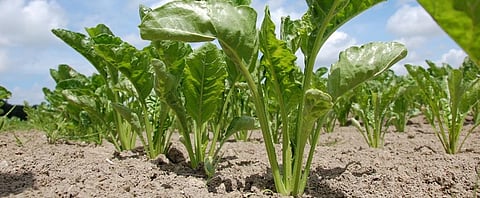Can sugar beet make sugar production in India sustainable
Around 68 per cent of India is prone to drought in varying degrees, according to a catergorisation adopted by the Union Ministry of Water Resources (MoWR).
Thirty-five per cent of the country is drought prone with annual rain between 750-1,125 millimetres, while 33 per cent is chronically drought prone, with annual rain less than 750 mm.
Irrigation water productivity in the traditional sub-tropical sugarcane region — in Bihar and Uttar Pradesh — was almost three times more than the tropical region that includes Karnataka, Maharashtra and Tamil Nadu.
This was pointed out by a 2018 study conducted by think-tank Indian Council for Research on International Economic Relations. Growing sugarcane, especially in Maharashtra, is not sustainable any longer, because of severely depleted groundwater levels along the state’s sugarcane belt, according to several studies conducted overtime.
While unsustainability is a major concern for every stakeholder in the industry, the all-powerful sugar lobby in India controls the future of the industry.
Beet has emerged as a global alternative to water-guzzling sugarcane when it comes to sugar extraction. This can considerably ease concerns around the crop’s sustainability in states like Maharashtra, where sugarcane eats into the irrigation resources of other crops.
India’s sugar lobby, however, has deep connections in the country’s political landscape, making the shift from cane to beet nearly impossible.
This dilemma also assumes significance because India’s demand for sugar is 25 million tonnes per year. The political patronage for sugarcane, however, has led to production exceeding 35 million tonnes, a recipe for disaster for the country’s farmers.
It is not surprising that political parties make sugarcane the focal point of smaller bye-polls and constituency rallies, as it is their main ticket to a vote bank and power.
Politicians have taken up the causes of cane farmers and lobbied for them with governments in attempts to grab power themselves someday, a practice that was cemented before Independence.
Like every other powerful industry, whose mode of production is unsustainable, the sugar industry is also at the crossroads of the environmental lobby and the sugarcane lobby.
Environmental activists have blamed Marathwada’s drought situation on sugarcane for long, accusing the crop of soaking up groundwater, a practice that placed other crops at a disadvantage.
A Maharashtra Water and Irrigation Commission formed under former Central Water Commission chairman Madhav Chitale pointed out that sugarcane cultivation consumed 71 per cent of Maharashtra’s irrigated water.
The state government had since promised a string of loans and development assistance packages from the National Bank for Agriculture and Rural Development to bring more area under drip irrigation in the state.
The introduction of sugar beet has faced long standing hindrances from the sugarcane lobby.
Scientists and researchers said sugar beet required less than a third of the water consumed by sugarcane, something that can be reduced more by using micro-irrigation.
The crop matures in four months, compared to the 15-month cycle of sugarcane. This can allow farmers to cultivate other crops and undertake animal husbandry and livestock raising.
Surplus beet can also be sold as a vegetable or further sold for blending with ethanol, a valuable feedstock. This can further the Prime Minister’s vision of doubling farmer incomes by 2020.
Research also pointed out that low sugar recovery (about 10-11 per cent) led to 200 million tonnes of bagasse (sugarcane husk residue after crushing and juicing) being incinerated, causing massive pollution, along with associated risks of stubble burning.
Sugar beets require smaller, farmer-controlled units and produce less waste to be burnt.
Small solar plants can be used to manage the electricity requirement of sugar beet units as well.
Huge investments and capital infusion is needed for expanding the production capacity of sugar factories. Sugar mill owners, however, owe farmers almost Rs 24,000 crore in arrears, according to reports.
This is a cruel paradoxical situation in India: Farmers, encouraged by their political masters to farm sugarcane, face an existential crisis.
Sugar beet has been side-lined by the powerful sugar lobby, while other countries have taken to cultivating sugar beet as a valuable cash crop.
Russia is the largest producer, followed by France, Germany and the United States. The interiors of Maharashtra have the apt climate and soil for growing it between November and March, according to the scientific requirements of the crop.
It is more cost-effective, time-effective and environment-sensitive and produces the same output, compared to sugarcane.
Environmentalists — citing the feeling that groundwater tables need time to recuperate — have also proposed a temporary ban on sugarcane, with the state government providing alternate livelihoods to farmers for this period.
It, however, remains to be seen if Maharashtra will find the political will to do so.


